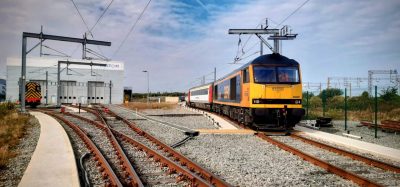RENFE finds unexpected answers to crowd congestion at Atocha
Posted: 27 September 2008 | | No comments yet
Sitting at the heart of Madrid’s extensive rail network, Atocha station is the biggest public transport interchange in the Spanish capital. Local rail lines, high-speed intercity services and metro lines from across the city come together here to provide an essential link for commuters, tourists and local residents alike. With hundreds of thousands of commuters and other rail travellers using the station every day, our primary aim is to ensure they are able to use transit safely and comfortably.
Sitting at the heart of Madrid’s extensive rail network, Atocha station is the biggest public transport interchange in the Spanish capital. Local rail lines, high-speed intercity services and metro lines from across the city come together here to provide an essential link for commuters, tourists and local residents alike. With hundreds of thousands of commuters and other rail travellers using the station every day, our primary aim is to ensure they are able to use transit safely and comfortably.
Sitting at the heart of Madrid’s extensive rail network, Atocha station is the biggest public transport interchange in the Spanish capital. Local rail lines, high-speed intercity services and metro lines from across the city come together here to provide an essential link for commuters, tourists and local residents alike. With hundreds of thousands of commuters and other rail travellers using the station every day, our primary aim is to ensure they are able to use transit safely and comfortably.
In recent years, passenger numbers at Atocha have risen sharply, putting pressure on the 19th century station. Of particular concern is the morning rush hour, when commuters arriving at Atocha via the suburban train lines transfer onto the Platform 1 services that take them into the centre of Madrid.
Relieving congestion; minimising disruption
It is clear that we now face a big challenge. Commuters pour into Atocha Cercanías on five platforms. From here, the majority of people – Madrid’s daily workforce – transfer onto just a single platform. If the congestion on Platform 1 was left to grow unchecked, the severe crowding that would result could become a major hazard for passengers waiting for trains.
For sometime now, RENFE has been looking at a long-term solution to the platform overcrowding. Its plan to ease congestion at Atocha involves major capital development work to divert several of the local rail routes to other stations in Madrid, effectively spreading the load of morning commuters more evenly across the city. However, within the Civil Protection, Safety and Risk Prevention department at RENFE OPERADORA, we felt it was important, from a safety point of view, to investigate the kinds of measures that could be taken in the short term to relieve congestion. We also wanted to test new technologies that could potentially be used in a centralised way from RENFE’s CECON, our new Centre of Coordination and Control.
Expecting the unexpected
The particular challenge when operating a major terminal such as Atocha, is trying to predict the outcome of any design and operational decisions before they are executed. The complexity of how passengers interact with each other and constituent infrastructure parts – retail outlets, ticket halls, transport modes – means it is all too easy to make assumptions about changes in one area only for there to be unintended consequences in another.
To test potential solutions to the congestion challenge at Atocha, Alsentia, a consultancy company specialised in pedestrian simulation, used Legion’s Pedestrian Simulation software to create a model of Atocha. The model was then used to test the impact of numerous potential changes to the station layout.
Currently, passengers access Platform 1, which runs trains to the city centre, via 10 escalators. These are arranged in up and down pairs: two pairs at the near end of the platform, two pairs in the centre of the platform, and the final pair at the far end of the platform.
We tested a number of scenarios. The results were not only clear and visual but they also allowed us to accurately test any operational changes well before anything was put into practice.
Ultimately, the pedestrian simulation study delivered a deep understanding of exactly how a terminal works, and how many elements come together to impact on the passenger experience. The results of the testing at Atocha proposed a clear solution.
Sometimes less is more
By removing two pairs of escalators and instituting a one-way system, we would be able to significantly reduce congestion on the platform. For the first stage, the team proposed removing the two pairs of escalators from the centre of one platform, which 60% of the passengers interchanging to Platform 1 currently use. This change would free some 100m2 of effective space, enough room for 250 more people at any given time on the platform. It would also improve visibility and accessibility, providing a more even use of the space along the platform.
For the second stage of the proposal, a one-way system for the escalators was suggested. This would be achieved by turning the four pairs of escalators at the near end of the platform from up and down pairs to ascending only, and by turning the pair at the far end to descending only, thereby providing the only way to access the platform. This one-way system would mean people have to walk further; it would effectively delay their arrival on the platform. This slowdown would deliver a 15% drop in passenger density on the platform – a significant gain from a relatively small investment.
Next, we considered the safety aspects of the proposed changes, in particular what would happen if we needed to evacuate the platform. We wanted to test our natural assumption that by removing four escalators – 40% of the total serving the platform – the evacuation time for the platform would necessarily be extended. We were wrong. In fact, the evacuation time for the platform would be unchanged. The reason for this startling result is actually quite logical. Removing the four escalators from the centre of the platform not only gives passengers more room on the platform, but it also leads to much improved circulation – passengers moving about on the platform itself. In an evacuation scenario, this means more passengers on the platform are able to reach the exits much more easily.
The simulations demonstrated that four of the escalators on Platform 1 were essentially unnecessary. It is interesting to note that all of Atocha’s five platforms have the same 10-escalator layout as Platform 1.
Findings
The good news for users of Atocha is that while we were conducting this study, RENFE decided to speed up the implementation of its planned long-term solution to congestion at the station.
However, with this project, we’ve seen just how powerful pedestrian simulation technology can be in a fully operational station. By being able to test changes to Atocha’s layout and operations before implementing them, we could be sure that the solution we had arrived at was the right one.
For designers and operators of major pedestrian-friendly infrastructure projects, it is clear that this kind of advanced pedestrian simulation technology has the power to deliver significant savings both in time and money. In the short term it allows project owners to reduce or even eliminate expensive and time-consuming remedial work. It also allows building design teams to account for long-term growth or changes to user numbers in their plans and, therefore, to build longevity into the life of the asset.
This study gave us a better understanding of how Atocha actually works for the multitude of passengers who negotiate its platforms every day. I am confident that the proposed alterations to Atocha’s layout suggested by the simulations would deliver a much improved passenger experience at the station, and we shall not hesitate to use this technology for future projects at stations across Spain.
Stay Connected with Global Railway Review — Subscribe for Free!
Get exclusive access to the latest rail industry insights from Global Railway Review — all tailored to your interests.
✅ Expert-Led Webinars – Gain insights from global industry leaders
✅ Weekly News & Reports – Rail project updates, thought leadership, and exclusive interviews
✅ Partner Innovations – Discover cutting-edge rail technologies
✅ Print/Digital Magazine – Enjoy two in-depth issues per year, packed with expert content
Choose the updates that matter most to you. Sign up now to stay informed, inspired, and connected — all for free!
Thank you for being part of our community. Let’s keep shaping the future of rail together!







